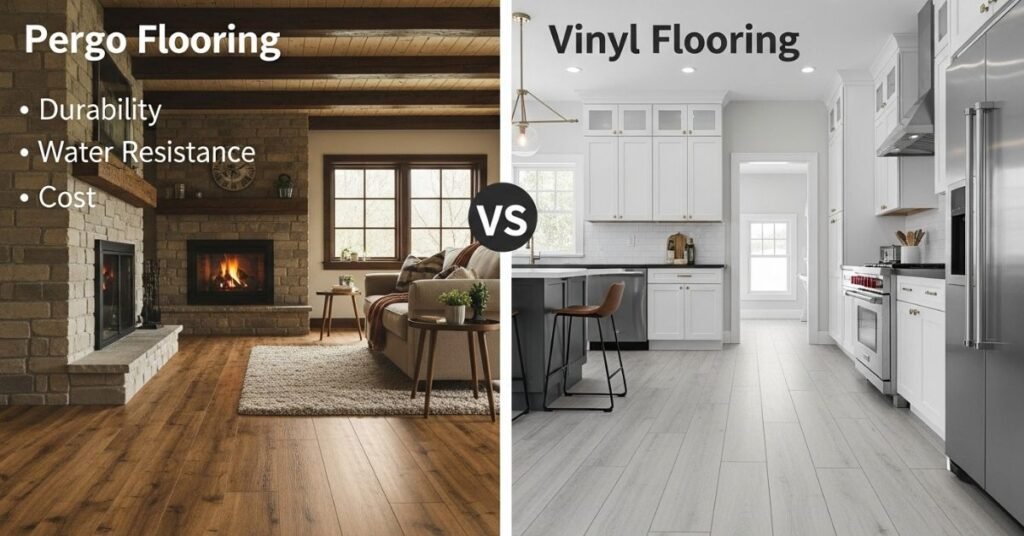Choosing the right flooring for your home is a big decision. It sets the tone for your space, withstands daily life, and impacts your budget. Two popular choices you’ll often encounter are Pergo and vinyl. While they might look similar at first glance, they have key differences that could make one a much better fit for your home than the other.
This guide will break down the Pergo vs. vinyl debate. We will compare them on durability, cost, appearance, installation, and upkeep. By the end, you’ll have a clear idea of which material is the right choice for your lifestyle and design goals.
What Is Pergo Flooring?
Pergo is not actually a type of flooring but a leading brand of laminate flooring. Since its invention, the name has become almost synonymous with the product itself, much like Kleenex is for tissues. Laminate flooring consists of multiple layers fused together.
- Wear Layer: A tough, clear topcoat that protects against scratches, stains, and fading.
- Design Layer: A high-resolution photo of wood, stone, or other materials. This is what gives the plank its look.
- Core Layer: A high-density fiberboard (HDF) that provides stability and impact resistance.
- Backing Layer: A bottom layer that adds stability and moisture resistance.
Pergo is known for its realistic wood looks and exceptional durability, making it a strong contender for busy households.
What Is Vinyl Flooring?
Vinyl flooring has come a long way from the peel-and-stick sheets of the past. Modern vinyl, especially Luxury Vinyl Tile (LVT) and Luxury Vinyl Plank (LVP), is a sophisticated and versatile flooring option. It is a synthetic product made primarily from PVC (polyvinyl chloride).
Like Pergo, vinyl is constructed in layers:
- Wear Layer: A protective topcoat that guards against scuffs and scratches.
- Print Layer: The decorative layer that features the wood or stone pattern.
- Core Layer: This is the main difference. It can be flexible or a rigid core, often called SPC (Stone Plastic Composite) or WPC (Wood Plastic Composite). This core is what makes vinyl flooring 100% waterproof.
- Backing Layer: An attached underlayment for cushioning and sound absorption.
Vinyl’s biggest selling point is its waterproof nature, making it suitable for any room in the house.
Head-to-Head Comparison: Pergo vs. Vinyl
Let’s put these two flooring giants side-by-side to see how they stack up in the areas that matter most to homeowners.
Durability and Lifespan
Your floors take a beating from foot traffic, pets, kids, and furniture. Durability is non-negotiable.
- Pergo: Pergo’s top wear layer is incredibly tough and highly resistant to scratches, dents, and stains. It’s an excellent choice for high-traffic areas like living rooms and hallways. However, its HDF core is made of wood composite, which makes it susceptible to water damage. Spills need to be wiped up quickly to prevent the planks from swelling or warping.
- Vinyl: The main advantage of vinyl is that it is 100% waterproof. This makes it the undisputed champion for wet areas like bathrooms, kitchens, and basements. While high-quality vinyl has a strong wear layer, it can be more prone to deep scratches or gouges from sharp objects compared to Pergo.
Winner: Vinyl, for its waterproof construction. However, for scratch resistance in dry areas, Pergo has a slight edge.
Aesthetics and Appearance
You want your floors to look great and match your home’s style. Both options offer a wide range of designs.
- Pergo: Thanks to advanced printing technology, Pergo offers incredibly realistic wood-look planks. The texturing and high-definition imagery can make it difficult to distinguish from real hardwood at a glance. It excels at mimicking various wood species, grains, and finishes.
- Vinyl: Vinyl also provides a vast selection of styles, including convincing wood and stone visuals. LVT and LVP have improved significantly, with many options featuring embossed textures that align with the printed pattern. However, some lower-end vinyl can still look artificial or “plastic-y.”
Winner: Tie. Both offer fantastic, realistic options. Your choice will likely come down to the specific design and finish you prefer.
Cost and Value
Budget is often a deciding factor. Here’s how they compare in terms of price.
- Pergo: Laminate flooring is generally considered a budget-friendly option. Prices can range from $2 to $5 per square foot for materials. Pergo, as a premium brand, tends to be in the mid-to-high end of that range.
- Vinyl: The price of vinyl flooring varies widely. Basic sheet vinyl can be very cheap, but LVP and LVT typically range from $2 to $7 per square foot. High-end, rigid core vinyl can sometimes be more expensive than laminate.
Winner: Pergo, by a small margin. It often provides a premium look for a slightly lower upfront cost than comparable luxury vinyl.
Installation
Ease of installation can save you time and money, whether you’re DIY-ing or hiring a pro.
- Pergo: Most Pergo flooring uses a click-lock system, making it a popular DIY project. The planks snap together easily over an underlayment. The subfloor needs to be clean and level, but minor imperfections are often acceptable.
- Vinyl: Vinyl planks also commonly use a click-lock system. Because it’s more flexible, vinyl is less forgiving of subfloor imperfections. Any bumps or dips in the subfloor can transfer through to the surface over time. Proper subfloor preparation is crucial for a successful vinyl installation.
Winner: Pergo. Its rigid planks make it slightly more forgiving and easier for first-time DIYers.
Maintenance and Cleaning
Everyone wants a floor that’s easy to care for.
- Pergo: Cleaning is simple. Regular sweeping or vacuuming (with the beater bar off) and occasional damp mopping with a manufacturer-approved cleaner is all it takes. The key is to avoid excessive water.
- Vinyl: Vinyl is just as easy to clean. Sweeping, vacuuming, and mopping are standard care. Since it’s waterproof, you don’t have to worry about water damage, making it perfect for mopping up bigger messes.
Winner: Vinyl. Its waterproof nature makes cleaning completely worry-free.
Which Flooring Is Right for You?
So, how do you make the final choice? It comes down to your specific needs and the room you’re renovating.
Choose Pergo if:
- You need maximum scratch resistance for pets and heavy foot traffic in dry areas.
- You are looking for the most realistic wood look on a moderate budget.
- You plan to install the flooring yourself and want a more forgiving material.
- The room is a bedroom, living room, or hallway.
Choose Vinyl if:
- You are flooring a bathroom, kitchen, laundry room, or basement.
- Waterproofing is your number one priority.
- You want a floor that is very quiet and comfortable underfoot (especially WPC vinyl).
- You need a durable flooring solution for a rental property.
Ultimately, both Pergo and vinyl are excellent flooring choices that offer durability and style without the high cost of natural materials. By considering the primary use of your space and weighing the factors of water resistance, durability, and aesthetics, you can confidently select the perfect floor for your home.


